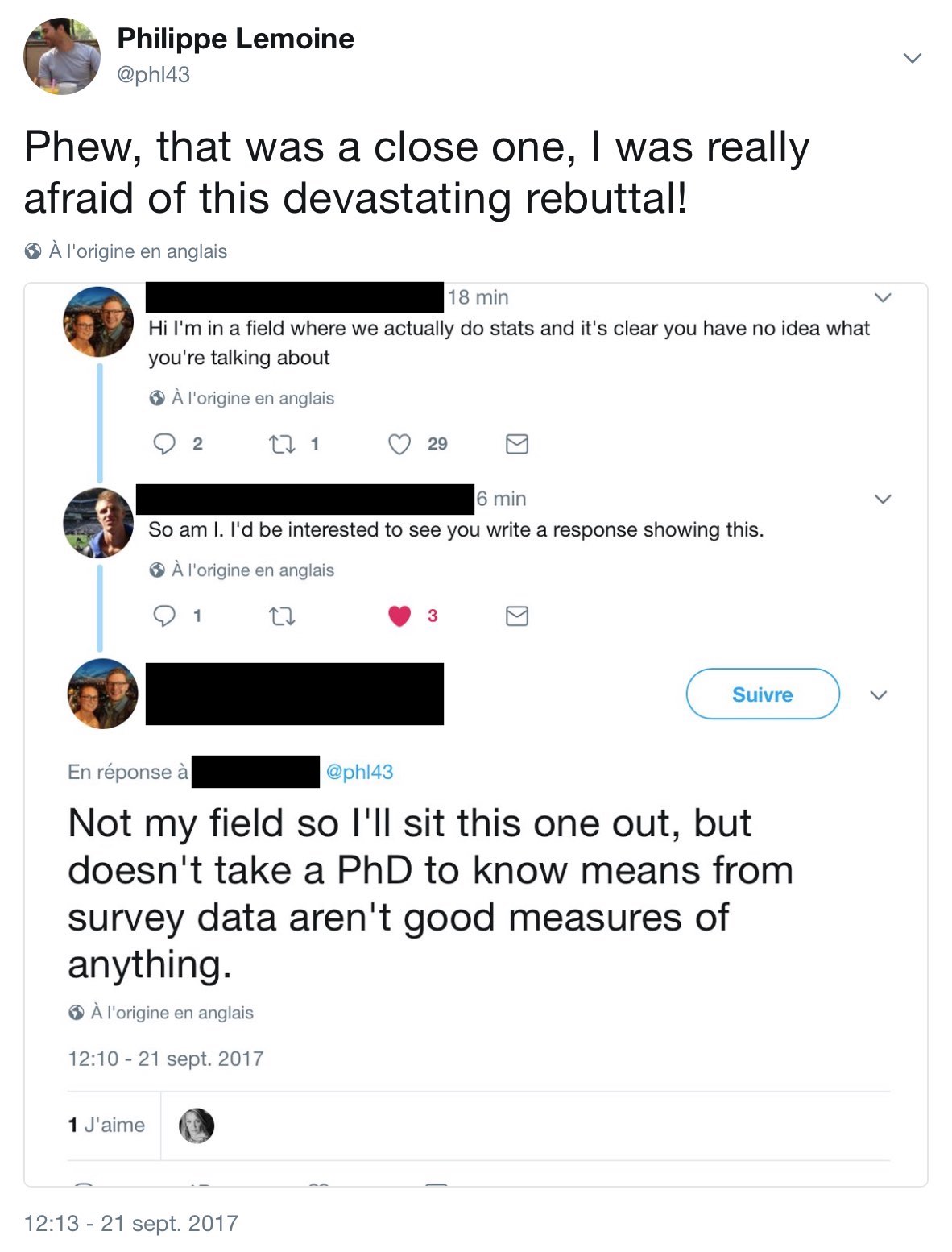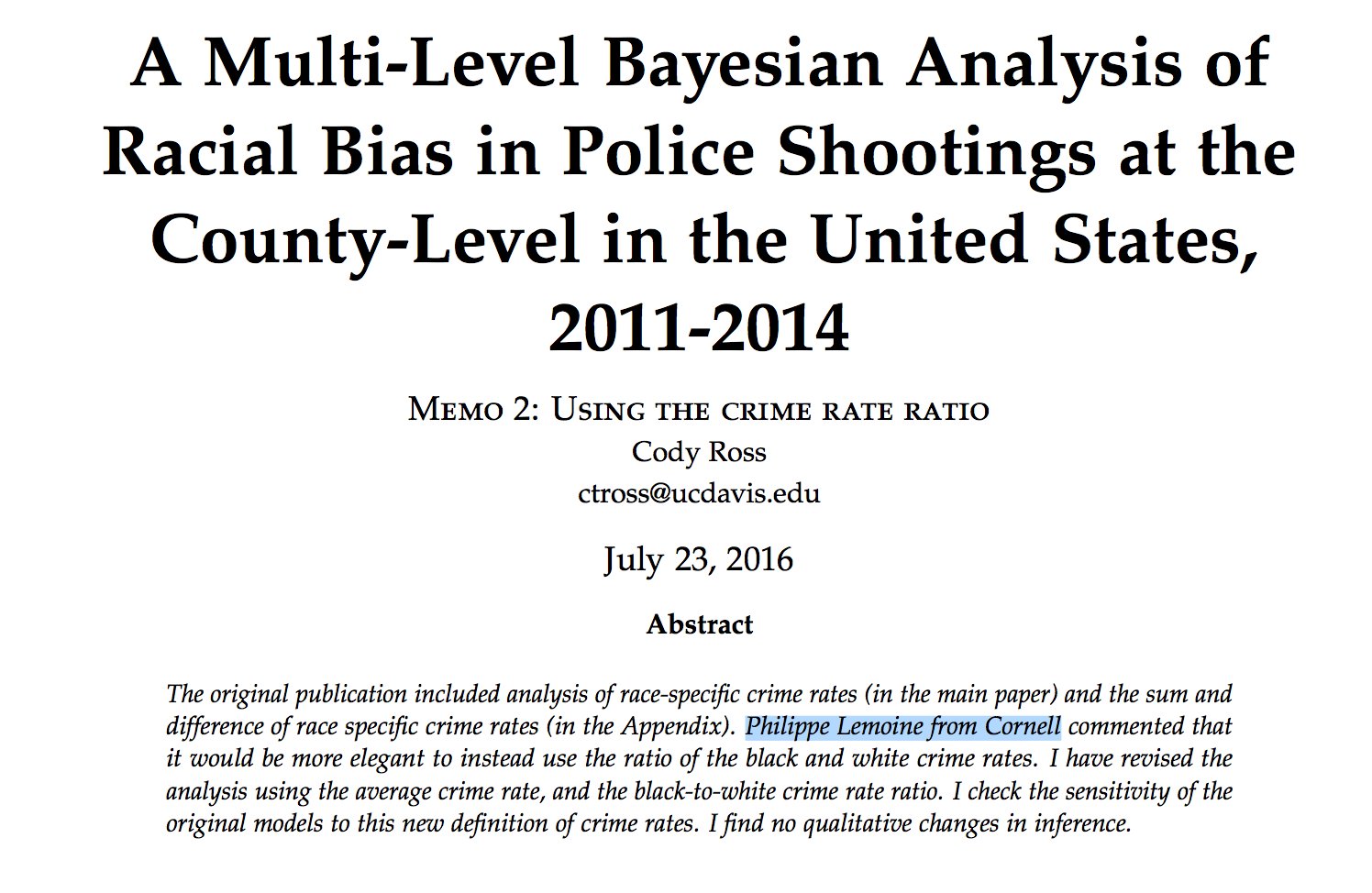I don’t have time to write another post for the blog at the moment, though I have several of them in the works, but I wanted to let you know about a few things I published elsewhere. I already mentioned that Areo had published my post about conservatives in academia, but I also published a shorter version of my essay on police violence. Another, even shorter version was published in the National Review, which brought quite a lot of attention to it from people I didn’t expect. (In particular, Andrew Sullivan talked about my essay in New York Magazine, which is pretty cool.) A lot of it has been positive, but it was also heavily criticized. For instance, Jamelle Bouie wrote a short and badly confused rebuttal on Twitter, to which I replied after making fun of him. His followers didn’t like that, so they piled up on me, which was a lot of fun. Bouie’s followers didn’t like that I make fun of him, but it didn’t bother them that he transparently suggested I was a racist when he criticized my article. It never ceases to amaze me how people have no problem accusing you of vile shit, only to start crying when you don’t show the other cheek…
Bouie’s followers didn’t like that I make fun of him, but it didn’t bother them that he transparently suggested I was a racist when he criticized my article. It never ceases to amaze me how people have no problem accusing you of vile shit, only to start crying when you don’t show the other cheek…
Anyway, most of the objections people made against my piece during this episode were either confused or consisted in methodological criticisms so devastating they can’t be shared with the world, as illustrated by the brief exchange I showed above. But several people also mentioned a study by Cody Ross about bias in police shootings, which they think refutes the hypothesis I make that most of the black/white disparity in the use of force by the police doesn’t result from bias, but from differences in behavior. This study was also mentioned by Joseph in the comments, who drew a similar conclusion from it. Some people suggested that I didn’t even know that study, but I’m actually quite familiar with it and, as it happens, I even had a brief correspondence with its author who thanked me in a subsequent memo for suggesting a robustness check. I just don’t think this study shows what people think it does. Some of the issues with the conclusion people draw from it, such as the possibility that it fell prey to the ecological fallacy, have already been flagged by Ross himself in the paper.
I just don’t think this study shows what people think it does. Some of the issues with the conclusion people draw from it, such as the possibility that it fell prey to the ecological fallacy, have already been flagged by Ross himself in the paper.
I would like to write a thorough discussion of this paper, but I don’t know when I will have time so I make no promises as to a precise timeline, since I have several other posts in the works that I want to publish before that. (One of them is about gun control and the other about the argument that restrictions to freedom of speech are justified by the rise of the nazis, but I also want to finish some of the posts I mentioned a few weeks ago, which I didn’t publish yet because other things came up after that.) In any case, my post wasn’t about bias in the police (I don’t think it’s possible to learn much about this from the PPCS), which I only brought up because I wanted people to understand that one can’t infer bias from the existence of a disparity. The main goal of my post was to show that unjustified police violence against black men is extremely rare which, as I explicitly point out in my essay, would still be true even if the black/white disparity in the use of force by the police was entirely the result of bias. Anyway, I will publish more on the blog as soon as I have time, so stay tuned. By the way, sorry if you wrote a comment or sent me an email and I still haven’t replied, but again I have been quite busy.
Hi, I’m a black guy from brooklyn, and read your post with much interest, because it’s one of the few that tries to deal with these numbers using the Police Public Contact Surveys. Not sure what NO other journalist even bothered to do so.
Well I did my own amateur statistics and here’s what I found by comparing the 2011 PPCS to the number of people killed by police listed in The Guardian’s database from 2016(which I think is the best one).
20,315,969 white people had contact with police. 8.42% of population
0.0028% (584) were killed.
6,678,188 black people had contact with police. 2.77% of us population.
0.0045% (307) were killed.
So it seems that out of the population that actually encounters police blacks are only 1.6 times as likely as whites to be killed. Is this correct? Interested in hearing your thoughts!
I’m glad you found my post interesting. For reasons I explain in it, I didn’t look at the PPCS of 2011 and I don’t have time to check right now, so I can’t confirm the figures you give. But assuming they are accurate, and that you are really talking about the number of people who had a contact with the police for each race and not the number of contacts for each race, then your conclusion is correct. Otherwise it probably underestimates somewhat the extent to which black people are more likely to be killed by the police than white people, because it seems that, relative to contacts with white people, contacts with black people seem to be more concentrated on a fraction of the population, i. e. for the same number of contacts, less black people than white people had a contact, because black people are more likely to have multiple contacts during the year.